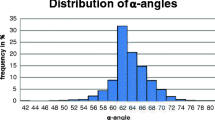Abstract
The etiology of inborn hip dysplasia is unknown. In general, a multifactorial genesis is assumed. The influence of hormones on the development of the fetal hip joint and its stability is discussed as well as mechanical influences. This study was carried out with the intention to examine the correlation between the concentration of the pregnancy hormone relaxin and the stability of the hip joint in newborns. Both hips of 90 newborn children were examined clinically and sonographically. In 25 hips (13.9%), pathological sonograms according to the classification of Graf were found. The relaxin concentration was measured in cord blood using a heterologous radioimmunoassay. Statistical evaluation revealed an insignificant decrease of relaxin concentration with increasing sonographic hip instability. The results indicate that hip instability frequently occurs with decreasing relaxin concentration. These facts contradict the earlier assumption that hip instability coincides with increased relaxin concentrations in newborns. We assume that there is a worse preparation of the pelvis and the birth canal during pregnancy due to the lower relaxin concentration and thus that there could be a higher pressure on the fetus in the perinatal phase. A decreased relaxin concentration seems to have no direct effect on the hip joint tissue, but indirectly there is consequent rigidity of the tissue in mother and child, which
Similar content being viewed by others
References
Anders G (1982) Früherkennung und funktionelle Behandlung der Hüftysplasie und Hüftluxation. Z Orthop 120:100–104
Casser HR (1992) Sonographiegesteuerte Behandlung der dysplastischen Säuglingshüfte. Ferdinand Enke Verlag, Stuttgart
Dunn PM (1974) Congenital postural deformities: further perinatal associations. Proc R Soc Med 67:32–36
Dunn PM (1976) Perinatal observations on the etiology of congenital dislocation of the hip. Clin Orthop 119:11–22
Entenmann AH (1990) Humanes Relaxin aus Placenta. Versuche zur Isolierung, biologische Aktivität and klinische Studien. Dissertation Fakultät für Chemie und Pharmazie, Tübingen
Entenmann AH, Lippert TH, Seeger HM, Kieback DG, Voelter W (1984) Identification of immunologically active relaxin in fetal blood. IRCS Med Sci 12:881
Fettweis E (1973) Das Hüftluxationsleiden bei in Beckenendlage geborenen Kindern. Z Orthop 111:168–178
Franke J, Fengler F, Ackermann HJ, Brauer G (1976) Unsere Behandlung der sogenannten angeborenen Hüftluxation unter besonderer Berücksichtigung der transiliakalen Beckenosteotomie nach DEGA. Z Gesamte Hyg 22:919–925
Graf H (1987) Relaxin- and STH-Spiegel sowie freies Hydroxyprolin im Serum bei normaler Schwangerschaft und Zervixinsuffizienz. Dissertation Med. Fakultät, Köln
Graf R (1989) Sonographie der Sauglingshufte. Ein Kompendium von Graf R unter Mitarbeit von Schuler P, Vol 43, 3rd edn. Ferdinand Enke Verlag, Stuttgart
Hisaw FL, Zarrow MX (1950) The physiology of relaxin. Vitamins and hormones VIII:151–178
Hisaw FL, Zarrow MX, Money WL, Talmage RVN, Abramowitz AA (1944) Importance of the female reproductive tract in the formation of relaxin. Endocrinology 34:122–134
Hudson P, Haley J, John M, Cronk M, Crawford R, Haralambidis J, Tregear G, Shine J, Niall H (1983) Structure of a genomic clone encoding biologically active human relaxin. Nature 301:628–631
Koay ESC, Too CKL, Greenwood FC, Bryant-Greenwood GD (1983) Relaxin stimulates collagenase and plasminogen activator secretion by dispersed human amnion and chorion cells in vitro. J Clin Endocrinol Metab 56:1332–1334
Koay ESC, Bryant-Greenwood GD, Yamamoto SY, Greenwood FC (1986) The human fetal membranes: a target tissue for relaxin. J Clin Endocrinol Metabol 62:513–521
Lippert TH, Göd B, Voelter W (1981) Immunoreactive relaxinlike substance in milk. IRCS Med Sci 9:295
Löffler L, Kernert F (1987) Spontanentwicklung der Neugeborenenhüfte. Ultraschall Klin Praxis [Suppl 1] 263:75
MacLennan AH (1981) Relaxin — a review. Aust NZ J Obstet Gynaecol 21:195–202
Pfeil J, Niethard FU, Barthel S (1988) Klinische und sonographische Untersuchung der Säuglingshüfte. Z Orthop 126:629–636
Schwabe C (1983) N-α-formyl-tyrosil-relaxin — a reliable tracer for relaxin radioimmunoassay. Endocrinology 113:814–815
Strecker H, Hachmann H, Seidel L (1979) Der Radioimmunoassay (RIA), eine hochspezifische, extrem empfindliche quantitative Anal ysenmethode. Chemikerzeitung 103:53–68
Struck H. (1972) Untersuchungen über Reinigung, Bestimmung und Wirkung des Relaxins. Forschungsbericht des Landes NRW, Westdeutscher Verlag, Opladen
Tönnis D (1984) Die angeborene Hüftdysplasie and Hüftluxation im Kindes- und Erwachsenenalter. Springer, Berlin Heidelberg New York
Tredwell SJ, Bell HM (1981) Efficacy of neonatal hip examination. J Pediatr Orthop 1:61–65
Ueno M, Bryant-Greenwood GD (1981) Preliminary studies on the binding of relaxin to human fetal membranes. In: Bryant-Greenwood GD, Niall HD, Greenwood FC (eds) Relaxin. Elsevier, Amsterdam
Von Maillot K, Weiß M, Nagelschmidt M, Struck H (1977) Muttermundseröffnung und Relaxin. Arch Gynäk 223:323–331
Weiß M, Nagelschmidt M, Struck H (1979) Relaxin and collagen metabolism. Horm Metab Res 11:408–410
Wilkinson JA (1985) Congenital displacement of the hip joint. Springer, Berlin Heidelberg New York
Author information
Authors and Affiliations
Rights and permissions
About this article
Cite this article
Forst, J., Forst, C., Forst, R. et al. Pathogenetic relevance of the pregnancy hormone relaxin to inborn hip instability. Arch Orthop Trauma Surg 116, 209–212 (1997). https://doi.org/10.1007/BF00393711
Received:
Issue Date:
DOI: https://doi.org/10.1007/BF00393711




